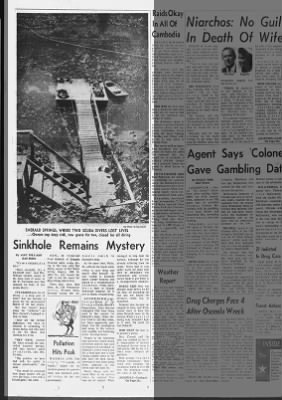Actually, we started the decompression at 40 feet, as I recall. (That was March 25th, 1975, 48 years ago.) It may have been 30 feet. Larry Murphy was in charge of that aspect, and we had regulators set up off the oxygen storage tanks at the various depths. I just went over my dive logs, and was not able to determine which depth we started on oxygen. The one note that I had was that we used "cave bottom time," which was defined as the time we left the surface until the time of our first decompression stop, which included ascent time.@John C. Ratliff,
My oxygen exposure table (NOAA) maxes out at 1.6 ATA PO2. Do you have a source for oxygen exposure tables that go up to 3.0 ATA? For purely academic reasons, I am trying to get a sense of the implications on deco if one switches to oxygen at 60 ffw when ascending from a deep air dive to 200 ffw for 30 minutes (say).
TIA,
rx7diver
I just looked in Google Scholar, searching for "oxygen decompression in 1975," and found this article from 1975:
Now, I just found this publication, which is on-line and free.
Dysbarism-related Osteonecrosis
books.google.com
It turns out that I have that publication, and it is titled "Dysbarism-Related Osteonecrosis, A Symposium." I just pulled it from my library, and it is dated 1974. There was a lot of concern about osteonecrosis in divers and one chapter is titled "Decompression Tables in Relation to Dysbaric Osteonecrosis," by Claude A. Harvey. In it there is this quote:
Behnke (1967) has discussed the principles of isobaric ("oxygen window") decompression, a technique that theoretically avoids bubble formation but "calls for too long a decompression for dives up to one-hour duration, unless it is feasible to breathe pure oxygen for a prolonged period at the +15 psi level." He points out that lengthy half-times, such as those analyzed in Tables II, III, and IV herein, seem much too long to be consistent with the limited physiological data available on N2 elimination in man. They have been employed, he suggests, only because models used to calculate tables may have questionable physiologic bases. Behnke adds: "It is likely that decompression practice in the past has served to initiate bubble evolution which subsequently has been controlled by prolonged stage decompression at relatively shallow depth."...
So I think Larry Murphy was using state-of-the-art oxygen decompression at the time to decrease the presence of "silent bubbles" and subsequent dysbarism-related osteonecrosis.
SeaRat




